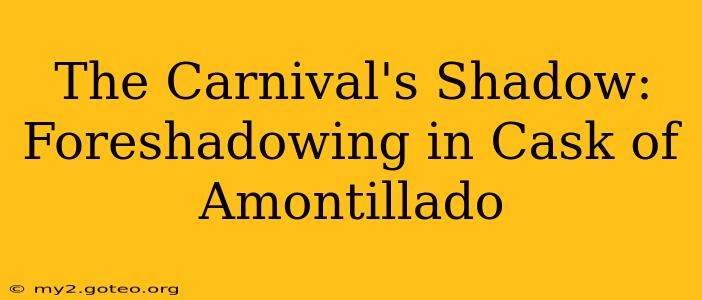Edgar Allan Poe's "The Cask of Amontillado" is a masterclass in suspense, a chilling tale of revenge meticulously crafted through masterful foreshadowing. The story isn't simply a recounting of a murder; it's a slow, deliberate descent into darkness, foreshadowed from the very first sentence. This essay will explore the subtle and overt ways Poe uses foreshadowing to heighten the tension and prepare the reader for Fortunato's gruesome fate. We'll delve into specific examples, analyzing how Poe's skillful use of imagery, dialogue, and setting creates a palpable sense of dread that lingers long after the final word.
The Setting: A Carnival of Deception
The story begins during carnival season, a time of revelry and excess, but also of disguise and hidden intentions. This setting itself acts as a powerful foreshadowing device. The festive atmosphere masks the sinister events about to unfold, creating an unsettling juxtaposition that mirrors Montresor's deceptive nature. The revelry is a deceptive facade, a carnival of masks concealing the true intentions lurking beneath. This initial contrast between outward celebration and inward darkness sets the stage for the tragedy to come.
How does the setting of the carnival contribute to the overall atmosphere of the story?
The carnival setting establishes a crucial element of irony. While everyone else is celebrating, Montresor is plotting a cold-blooded murder. This contrast emphasizes the deceptive nature of Montresor and foreshadows the hidden violence that will soon erupt beneath the surface of the festivities. The chaotic and masked nature of the carnival allows Montresor to blend into the crowd, acting as a perfect cover for his sinister plan. The revelry provides a distraction, masking the sound of Fortunato's cries and allowing Montresor to carry out his act without immediate interruption.
Fortunato's Weakness: A Self-Fulfilling Prophecy
Fortunato's pride and vanity are prominently displayed from the outset. Montresor cleverly manipulates these weaknesses, using them to lure him into the catacombs. This manipulation itself is a form of foreshadowing. Montresor's skillful flattery and the offer of a rare wine are clearly designed to exploit Fortunato's weaknesses, and the reader can anticipate the tragic consequences. Fortunato's repeated boasts about his expertise in wine act as a grim foreshadowing of his impending doom, his pride blinding him to the danger he's walking into.
What are the key character flaws that contribute to Fortunato’s demise?
Fortunato’s pride and his intoxication are his crucial downfalls. His inebriated state clouds his judgment, making him increasingly susceptible to Montresor's manipulation. His pride prevents him from recognizing the danger and turning back, even when he experiences doubts and discomfort. This combination of weakness and intoxication ensures his vulnerability to Montresor’s scheme, effectively foreshadowing his eventual fate.
Omens and Symbolic Imagery: A Path to Destruction
Poe masterfully employs symbolic imagery throughout the narrative. The catacombs themselves are a powerful symbol of death and decay, foreshadowing Fortunato's ultimate fate. The dampness, the darkness, and the echoing silence all contribute to an atmosphere of impending doom. Montresor's family coat of arms, with its motto "Nemo me impune lacessit" (No one attacks me with impunity), serves as a chilling foreshadowing of the revenge to come, hinting at the unwavering nature of Montresor's retribution.
How does Poe use symbolism to enhance the suspense and foreshadowing in the story?
The recurring imagery of darkness, dampness, and decay in the catacombs strongly foreshadows Fortunato's death. These elements mirror the decline of Fortunato’s physical and mental state as he ventures deeper into the catacombs. Similarly, the coat of arms acts as a direct and ominous foreshadowing of the story's conclusion, highlighting the inevitable consequences of offending Montresor.
The "Amontillado": A Bait and a Symbol
The cask of Amontillado itself serves as both bait and symbol. It's the lure that draws Fortunato into the catacombs, but it also represents the ultimate prize for Montresor – the satisfaction of his revenge. This dual role adds another layer of foreshadowing. The reader understands that the Amontillado is not simply a gift; it's a crucial part of Montresor's deadly plan, representing the fulfillment of his vengeance.
What is the significance of the cask of Amontillado in terms of foreshadowing?
The Amontillado serves as a powerful symbol of Montresor's manipulative plan. It lures Fortunato into the depths of the catacombs, acting as a potent foreshadowing of his demise. The very act of pursuing the wine symbolizes Fortunato's descent towards his own death, mirroring the descent into the catacombs themselves.
In conclusion, Poe's skillful use of foreshadowing in "The Cask of Amontillado" transforms a simple tale of revenge into a chilling masterpiece of suspense. Through careful manipulation of setting, character flaws, symbolic imagery, and the very object of the narrative's focus, the Amontillado itself, Poe creates an atmosphere of dread that is both terrifying and unforgettable. The reader is not merely a passive observer but an active participant in the unfolding tragedy, acutely aware of the impending doom thanks to the author's masterful use of foreshadowing.

